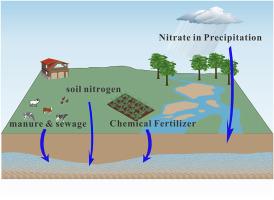莱芜地下水水化学演化与硝酸盐污染源:来自水化学和双同位素分析的启示
IF 4.1
3区 地球科学
Q2 GEOSCIENCES, MULTIDISCIPLINARY
引用次数: 0
摘要
有效的地下水保护从根本上依赖于对主要影响因素和污染源的准确识别。本文采用统计和水化学方法、双同位素方法和贝叶斯混合模型(MixSIAR)对断陷盆地的81份地下水样品进行了分析,以确定地下水的潜在污染源及其贡献。结果表明,受自然过程(如硅酸盐和碳酸盐风化和溶蚀)以及人为硝酸盐输入的驱动,SO4·Cl-Ca·Mg和HCO3-Ca·Mg类型的水化学相占主导地位。值得注意的是,超过九成样本的硝酸盐浓度超标。利用克里格法对流域硝酸盐污染进行空间分析,发现污染主要集中在流域下游。双同位素分析表明,土壤氮(SN)和粪肥污水(M&;S)是地下水硝酸盐的主要来源。MixSIAR模型结果进一步表明,SN和M&;S氮对地下水硝酸盐浓度的贡献率分别为30.66%和42.21%。本研究证明了水化学和MixSIAR方法在识别和量化地下水影响因素方面的有效性,并特别强调了将这些方法与工业部门调查联系起来的必要性。本文章由计算机程序翻译,如有差异,请以英文原文为准。

Hydrochemical evolution and nitrate contamination sources in Laiwu groundwater: Insights from hydrochemistry and dual-isotope analysis
Effective groundwater protection fundamentally relies on the accurate identification of primary influencing factors and pollution sources. In this study, 81 groundwater samples from a fault depression basin were analyzed using statistical and hydrochemical methods, the dual-isotope method, and the Bayesian Mixing Model (MixSIAR) to characterize groundwater and identify potential pollution sources and their contributions. Results reveal dominant hydrochemical facies of SO4·Cl–Ca·Mg and HCO3–Ca·Mg types, driven by natural processes such as Silicate and Carbonate weathering and dissolution, alongside anthropogenic nitrate inputs. Notably, the concentration of nitrate exceeded the permissible limit in over 90 % of the samples. Spatial analysis of nitrate pollution using the kriging method reveals the most of them were located in the lower reaches of the basin. Dual isotope analysis identified Soil Nitrogen (SN) and Manure and Sewage (M&S) as the primary sources of nitrate in groundwater. The MixSIAR model results further indicated that SN and M&S nitrogen contributed 30.66 % and 42.21 %, respectively, to groundwater nitrate concentrations. This study demonstrates the effectiveness of hydrochemical and MixSIAR methods in identifying and quantifying influencing factors of groundwater, with particular emphasis on the necessity of connecting these methods with the investigation of the industrial sector.
求助全文
通过发布文献求助,成功后即可免费获取论文全文。
去求助
来源期刊

Physics and Chemistry of the Earth
地学-地球科学综合
CiteScore
5.40
自引率
2.70%
发文量
176
审稿时长
31.6 weeks
期刊介绍:
Physics and Chemistry of the Earth is an international interdisciplinary journal for the rapid publication of collections of refereed communications in separate thematic issues, either stemming from scientific meetings, or, especially compiled for the occasion. There is no restriction on the length of articles published in the journal. Physics and Chemistry of the Earth incorporates the separate Parts A, B and C which existed until the end of 2001.
Please note: the Editors are unable to consider submissions that are not invited or linked to a thematic issue. Please do not submit unsolicited papers.
The journal covers the following subject areas:
-Solid Earth and Geodesy:
(geology, geochemistry, tectonophysics, seismology, volcanology, palaeomagnetism and rock magnetism, electromagnetism and potential fields, marine and environmental geosciences as well as geodesy).
-Hydrology, Oceans and Atmosphere:
(hydrology and water resources research, engineering and management, oceanography and oceanic chemistry, shelf, sea, lake and river sciences, meteorology and atmospheric sciences incl. chemistry as well as climatology and glaciology).
-Solar-Terrestrial and Planetary Science:
(solar, heliospheric and solar-planetary sciences, geology, geophysics and atmospheric sciences of planets, satellites and small bodies as well as cosmochemistry and exobiology).
 求助内容:
求助内容: 应助结果提醒方式:
应助结果提醒方式:


